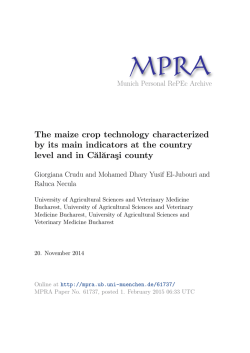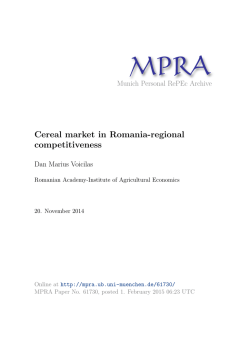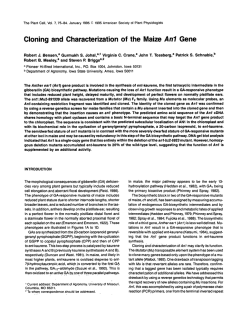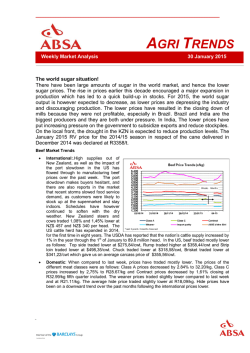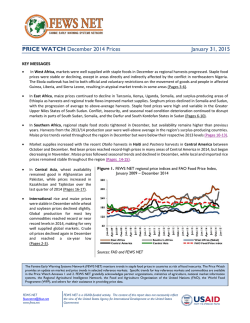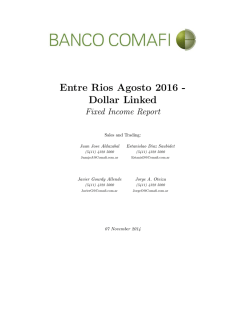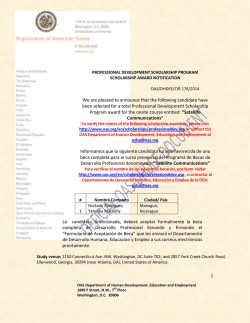
2014 Competitive Grants Initiative - Maize
MAIZE CGIAR Research Program Call for Proposals: 2014 Competitive Grants Initiative Deadline to hand-in proposals: 17th October 2014. Please return your completed proposal template to [email protected] Program Background and Objective – What is MAIZE? MAIZE is part of a concerted effort of the CGIAR to implement a new results-oriented strategy through a set of Research Programs that fully exploit the potential of international agricultural research for development (IAR4D) to enhance global food security, reduce poverty, and sustain the environment. Building on the input, strength and collaboration with over 300 partners, MAIZE combines the strength of farming communities, international and local public and private sector partners, policy makers, and development organizations to ensure that the CGIAR’s maize-research related contribution effectively contributes to the following Vision of Success: 1. Increasing demands for food are met, and food prices are stabilized at levels that are affordable for poor consumers. 2. Farming systems are more sustainable and resilient, despite the impacts of climate, and their dependence on irrigation and increasingly expensive fertilizers is reduced. 3. Increased production in developing countries is achieved mainly through higher yields, thus lessening pressure on forests, hill slopes, and other crops. 4. Poverty and malnutrition are reduced, especially among women and children, and a greater proportion of women and young adults are able to engage in profitable and environmentallyfriendly farming. 5. Developing countries are able to compete more vigorously in export markets and ensure benefits for a wide range of actors in the value chain of major food crops. 6. Disadvantaged farmers and countries gain better access to cutting-edge proprietary technologies through innovative partnerships, in particular with advanced research institutes and the private sector. 7. A new generation of scientists and other professionals is guiding national agricultural research across the developing world and working in partnership with the CGIAR, the private sector, policy makers and other stakeholders to enhance efficiency and impact. International Maize and Wheat Improvement Center / Website: www.cimmyt.org CGIAR Research Program on Maize /Website: www.maize.org Carretera Mexico-Veracruz, Km. 45, El Batán, Texcoco, Edo. de Mexico C.P. 56130 Mexico Telephone: Texcoco: +52 (595) 9521900, Fax: +52 (595) 9521983 Email: [email protected] International Institute of Tropical Agriculture / Website: www.iita.org MAIZE divides its research program into five Flagship Projects (see http://www.maize.org/). As part of its partnership strategy, MAIZE wants to extend its current partnerships to capture a wider range of innovative ideas, increase the quality of the research, and integrate the skills of the most able and well-connected members towards the Vision of Success. The MAIZE Competitive Grants Initiative allows scientists worldwide to apply for funds to support research and capacity-building activities that will make a significant contribution to the vision of success of MAIZE. Concept Notes are sought for one or more of the priority research areas below: Aligned with MAIZE Flagship Project 1 - Sustainable intensification of maize-based farming systems 1. Small scale mechanization for maize. The difficulty in finding farm labor is generating an increased interest in mechanization even in the developing areas of South and South East Asia and sub Saharan Africa. Poor access to labor, an inability to perform farm processes in a timely manner and poor seeding uniformity and application of fertilizers and crop protection products, all impact the growers potential to increase incomes. The potential exists then to mobilize currently available small 2 and 4 wheel tractors to improve the efficiency of farm operations and hence lead to potential increases in farm yields and incomes. The purpose of this call can be encapsulated in six outputs: (1) Identification of the most appropriate small scale technologies. The chosen maize mechanization options and associated target areas, based on yield/income improvements and prospective investments returns; (2) Develop business models and ROI calculations to support local investment in the agricultural engineering industries at domestic level, where possible. Imports are an acceptable alternate method to provide access to equipment; (3) Develop commercial pathways and models as to how these technologies can be introduced on a local level and the ultimately scaled up. What is critical is how growers are able to effectively access these innovations eg leasing, contract services, micro credit options etc.; (4) Options for mechanization must recognize regional heterogeneity in culture, farming systems and underlying system dynamics; (5) Outcomes should also include clear recommendations on equipment use with basic guides on agronomy where appropriate, and; (6) The program should include potential options for mechanization in: the different stages of maize production and associated value chain; different scales and models for operation; current and prospective options and, domesticated/local, imported or adapted options. The target region for this call is South and South East Asia. It is expected that the project should be developed in 2 phases: Phase 1 – The R&D component will evaluate what is available currently as well as to design, build and test other essential attachments. Phase 2 - Expand the learnings from the R&D component to other countries in the region. This phase to focus on the commercialization of the technologies, how to scale up the technology for wide spread impact as well as any minor local adaptation that might be required due to regional variations in farming, cultural and environmental conditions. Project duration is 36 months. USD$150,000 per annum is available for this call. Contact for further information: Mike Robinson ([email protected]) or Frederic Baudron ([email protected]). Aligned with MAIZE Flagship Project 2 - Novel tools, technologies and traits for improving genetic gains and breeding efficiency 2. Develop and/or validate and deploy new tools for high throughput phenotyping of high priority traits for maize (e.g. foliar disease symptoms). Phenotyping for foliar diseases in maize is often subjective, relying heavily on visual scores. High throughput field-based phenotyping tools (including image analysis) have been helpful in eliminating subjectivity, and provided an opportunity for proper quantification of abiotic stresses. The potential for such phenotyping tools is yet to be widely captured in screening for important foliar diseases of maize, especially in the tropics and in the developing countries. Development, validation and deployment of new phenotyping tools to monitor the severity and progression of important foliar diseases in maize, such as maize lethal necrosis (MLN), turcicum leaf blight (TLB), grey leaf spot (GLS), maize streak virus (MSV), would enable significant improvement in the throughput and precision of disease screening. This would also require effective resolution of some technical bottlenecks, especially when there is simultaneous occurrence of multiple foliar diseases. The purpose of this call is to develop and validate new, reliable, and high throughput field-based phenotyping tools for foliar diseases of maize and can be encapsulated in four outputs: (1) A new high throughput phenotyping tool to objectively and quantitatively assess high priority foliar disease traits in maize with potential application for maize breeding programs in emerging countries; (2) Good correlation with qualitative scores of foliar disease symptoms; (3) Capacity to clearly dissect and quantify mixed foliar disease infections in the field, and; (4) Open source software for data processing. The target region for this call is Global (but the field study should initially be based in sub-Saharan Africa). Project duration is 24 months (1 year for development of tool, and 1 year for validation). The grant available for this call is USD$75,000 per annum. Contact for further information: George Mahuku ([email protected]) or Jill Cairns ([email protected]) or BM Prasanna ([email protected]). International Maize and Wheat Improvement Center / Website: www.cimmyt.org CGIAR Research Program on Maize /Website: www.maize.org Carretera Mexico-Veracruz, Km. 45, El Batán, Texcoco, Edo. de Mexico C.P. 56130 Mexico Telephone: Texcoco: +52 (595) 9521900, Fax: +52 (595) 9521983 Email: [email protected] International Institute of Tropical Agriculture / Website: www.iita.org 3. Predictive crop modeling and decision-support systems: Potential of new crop models and variations integrating systems analysis, physiology and environmental information. The purpose of this call is to undertake a comprehensive assessment of the potential of predictive crop modeling and decision-support systems for MAIZE research-fordevelopment. The assessment must include collaborative work with MAIZE scientists to assess the potential of new crop models and variations to integrate systems analysis, physiology and environmental information and the challenges and opportunities for their deployment in MAIZE. Expected outputs include: (1) A technical report, and; (2) A journal (scientific, peer reviewed) paper. The target region for this call is global. Project duration is 12 months. The grant available for this call is USD$50,000. Contact for further information: Kindie Tesfaye Fantaye ([email protected]); Jill Cairns ([email protected]); Frederic Baudron ([email protected]); Kai Sonder ([email protected]). Aligned with MAIZE Flagship Project 4 - Aligning with and strengthening maize seed systems for effective product delivery 4. Test and deploy new maize hybrids (derived through MAIZE CRP) in the rain-fed maize regions of Central America. The purpose of this call is to promote and scale up the Seed Industry sector to better serve the Central American region, with high yielding maize hybrids of demonstrated adaptation in the rain-fed maize regions of the lowland tropics. The purpose of this call can be encapsulated in four outputs: (1) Pipeline and Portfolio development of 3 white maize hybrids and two yellow, adapted to the rain-fed maize regions of Central America. With proven performance exceeding currently available hybrids in the market; (2) Establishment of a maize hybrid evaluation Network with private & public collaborators; (3) Seed production data generation of the best performing hybrids to identify potential hybrids candidates for registration and varietal release, and; (4) Best practices transfer and training of seed companies personnel in seed technology/operations and seed business management. The target region for this call is the rainfed maize regions of Central America. Project duration is 36 months. The annual grant available for this call is USD$150,000. Contact for further information: Arturo Silva Hinojosa ([email protected]). Aligned with MAIZE Flagship Project 5 - Equitable and profitable maize futures 5. Maize seed system country case studies. The purpose of this call is to undertake a comprehensive analysis of the maize seed sector in key countries, including seed portfolio (release, use, source), market segmentation, key stakeholders, dynamic context (history and evolution) and political economy. The analysis will examine the adoption and impact of improved maize germplasm, challenges and opportunities and implications for research and development – both public and private. Project duration is 12 months. Three outputs are expected: (1) A technical report; (2) A journal (scientific, peer reviewed) paper, and; (3) A publicly available database (using data collected during this study). The target region for this call is developing countries focus (minimum 750,000 ha maize per year) – Latin America, Africa, Asia. The maximum grant available for this call is USD$ 25,000 per case study. At least one case study per target continent. Proposals can be either for individual countries or combination of countries. Contact for further information: Africa - Kennedy Lweya ([email protected]); Latin America - Laura Donnet ([email protected]); Asia - Christian Boeber ([email protected]). 6. Maize foresight and targeting poor maize consumers: research implications. The purpose of this call is to undertake an analysis of the evolving maize consumption and production scenarios from 2000 to 2015 to 2030 and implications for research and poor consumers. The analysis must include: (a) Spatially explicit dynamic analysis of maize consumption/use (food, feed, fuel) and production both of the recent past and near future to 2030; (b) Analysis of poor consumers as beneficiaries of maize research as a distinct target group; and (c) The dynamics in research supply (particularly private sector) expected in selected target areas. This includes global and disaggregated analysis (regional, country, sub-country); dynamics and underlying drivers and modifiers; implications and impacts. Expected outputs include: (1) A technical report; (2) A journal (scientific, peer reviewed) paper; (3) Maps, and; (4) A publicly available database (using data collected during this study). The target region for this call is global. Project duration is 12 months. The grant available for this call is USD$100,000. Contact for further information: Kai Sonder ([email protected]). 7. Understanding maize intensification (dis)incentives. The purpose of this call is to undertake comprehensive case studies to rigorously understand maize intensification processes in maize-based farming systems of developing countries. This specifically includes ways to intensify maize production and incentives and constraints (e.g. policy, markets, and agricultural services) to sustained improved maize technologies adoption by different household groups (e.g. gender) and agro-ecologies. The case studies will include but not be limited to: production risks/stability and income analysis, dynamic adoption analysis (if data allows), and value chain analysis through a gender lens. Expected outputs include: (1) A technical report; (2) A journal (scientific, peer reviewed) paper, and; (3) A publicly available database using data collected during this study. The target regions for this call are Latin America, Africa, and Asia. Project duration is 12 months. The grant available for this call is USD$ 25,000 per case study. At least one case study per target continent. Proposals can be either for individual countries or combination of countries. Contact for further information: Menale Kassie ([email protected]) and Santiago López Ridaura ([email protected]). International Maize and Wheat Improvement Center / Website: www.cimmyt.org CGIAR Research Program on Maize /Website: www.maize.org Carretera Mexico-Veracruz, Km. 45, El Batán, Texcoco, Edo. de Mexico C.P. 56130 Mexico Telephone: Texcoco: +52 (595) 9521900, Fax: +52 (595) 9521983 Email: [email protected] International Institute of Tropical Agriculture / Website: www.iita.org 8. The nutrition-cereal nexus: The evolving nutritional roles of maize for human nutrition through food and feed in developing countries. The purpose of this call is to undertake a rigorous review to establish the role of maize in human nutrition globally, in different contexts/geographies and over time. The review must take into account consumption modalities and pathways (directly as raw or processed food and indirectly as animal feed) and dynamics (changes over time and associated drivers). Output: A review paper published in recognized peer-reviewed journal. The target region for this call is global. Project duration is 12 months. The grant available for this call is USD$25,000. Contact for further information: Hugo De Groote ([email protected]) and Natalia Palacios ([email protected]) 9. Fertilizer-maize nexus in sub-Saharan Africa. The purpose of this call is to undertake a comprehensive analysis of the inter-linkages between improved maize seed and fertilizer use in sub-Saharan Africa. This includes disaggregated analysis (regional, country, maize agro-ecology); dynamics and underlying drivers and modifiers; implications and impacts. This includes their use as individual component technologies and in combination, and the associated challenges and opportunities (supply, use, relative prices) and implications for research and development – both public and private. Expected outputs include: (1) A technical report; (2) A journal (scientific, peer reviewed) paper, and; (3) A publicly available database (using data collected during this study). Project duration is 12 months. The grant available for this call is USD$50,000. Contact for further information: Menale Kassie ([email protected]) and Peter Craufurd ([email protected]). 10. Ex-ante analysis of alternative maize futures and pathways for doubling production. The purpose of this call is to undertake a forward looking analysis of maize: (a) To define target maize production domains; (b) To determine the requisite investments needed to potentially double maize production, and; (c) To assess implications and impacts, particularly to what extent the increased production would help reduce price volatility and help stabilize food prices, especially under climate change scenarios. Expected outputs include: (1) A technical report; (2) A journal (scientific, peer reviewed) paper, and; (3) A publicly available database (using data collected during this study). The target region for this call is global. Project duration is 12 months. The grant available for this call is USD$50,000. Contact for further information: Kai Sonder ([email protected]) 11. Capture and analyze existing knowledge and experiences in particular projects regarding integration of gender concerns in maize research, relating this to the different understandings of gender in MAIZE identified during the gender audit. The Gender Audit found that there are elements of gender-aware research design and practice in particular projects. This indicates that within the CRP there are examples of knowledge and skills regarding the integration of gender concerns in MAIZE research; examples which can be consolidated and built upon. Capturing, analyzing and documenting some of these examples would serve a number of purposes: o o o It would serve to document examples of MAIZE gender-aware practice It would allow sharing ‘internal’ examples with other researchers and teams as part of the process of strengthening capacity to undertake gender-aware MAIZE R4D. It would contribute to the evidence base for gender aware research upon which guidelines and tools to mainstream gender in the RMF and MAIZE Flagship Projects and Clusters of Activities can be developed. It is proposed to use a case-study approach, possibly complemented with other qualitative research methods (such as positive deviance and Most Significant Change ) to capture and analyze a small set of existing project-level examples of knowledge and experience on how to integrate gender concerns in maize or wheat research. The case studies should focus on activities/components of projects/projects that exemplify the different understandings of gender identified in the Gender Audit reports section 3.3 of this report. In particular, the case studies can include examples of: i) work that challenges prevailing assumptions about gender roles and relations in maize farming systems; ii) work that promotes transformative approaches, and iii) a focus on counting women and men. The case-studies could be undertaken by project teams under the guidance and leadership of gender experts, which would contribute to the development of internal staff gender capacity, while at the same time contributing to the knowledge base. Suggestions for case-studies: o o o Challenging assumptions about gender roles and relations in maize farming systems: Supporting women to take up non-conventional agricultural work by helping them forge new identities as mechanized tiller operators and service providers in CSISA Bangladesh. Promoting gender transformative approaches: Recognizing women’s agency and capacity as local leaders in HMRP Nepal. Behind the numbers: Undertaking qualitative research that explains women’s and men’s participation in DTMA activities, particularly PVS, and how this can influence breeders' indices (ESA). International Maize and Wheat Improvement Center / Website: www.cimmyt.org CGIAR Research Program on Maize /Website: www.maize.org Carretera Mexico-Veracruz, Km. 45, El Batán, Texcoco, Edo. de Mexico C.P. 56130 Mexico Telephone: Texcoco: +52 (595) 9521900, Fax: +52 (595) 9521983 Email: [email protected] International Institute of Tropical Agriculture / Website: www.iita.org Three outputs are expected: (1) A comprehensive report; (2) A Journal article, and; (3) A collection of 3 didactic cases aimed at agricultural scientists and research teams. The target region for this call is global. Project duration is 12 months. The grant available for this call is USD$75,000. The call is targeted towards Advanced Research Institutes. Contact for further information: Lone Badstue [email protected]. Eligibility and Award Information Each Priority Research Topic mentioned under different Strategic Initiatives of MAIZE provides guidance on eligibility. The proposed budgets and time periods are guidelines. They can be greater if so justified by deliverables but need to fit in the range of (USD$20,000 to USD$300,000). Ultimately only the best proposals will be supported. For every year of funding, a minimum of four milestones must be proposed. Continuation of funding depends on the achievement of key deliverables/milestones each year by the grantee and timely submission of semi-annual financial and technical reports. The number of awards is subject to the availability of funds. All funds will be disbursed under a Standard Letter of Agreement http://www.maize.org/. Selection Criteria Proposals will be evaluated by the MAIZE Management Committee based on the following criteria: A distinct and measurable project output. “A study published in an international peer-reviewed journal”; “A website that provides … information to 5,000 extension agents”, etc. A realistic sequence of milestones that shows a logical sequence of activities towards the project output. A clear description how the project output contributes to the goals and outputs of a particular MAIZE Strategic Initiative. Integration or links to ongoing MAIZE research (i.e. maize research taking place at CGIAR centers). Evidence for sizeable impact desirably with regional (i.e. cross-country) or global reach and impact. Research projects must either provide a distinct value to the international community (“policy options to reduce maize price fluctuations”) or generate a significant sized development outcome (“farm level fertilizer recommendations simulated for three ecologies that encompass 100,000 farm families”). Competence among contributors A detailed budget that is in relation to the work proposed; provision of matching funds. Process and deadlines The application must be submitted by e-mail to the MAIZE Program Manager by the 17th October, 2014 [email protected]. The application must include: o Concept note (see the format given below, pages 5-7) o Official endorsement from the institution(s) of the proposal and the proposed Letter of Agreement under which MAIZE funds will be distributed. In case you get in touch with the designated contacts, please ask a specific question that proves that you have familiarized yourself with the content of MAIZE and the particular Flagship Project, or otherwise ask for a date/time for a Skype discussion while giving some background why you are interested. No correspondence can be held with individuals that have not familiarized themselves with the information available on MAIZE as available on http://www.maize.org/. External reviewers assess Concept Notes by 30th of October, 2014. Proponents are expected to address reviewers’ comments by 6th of November, 2014. Proponents will be informed about accepted proposals by 20th of November, 2014. Funds are disbursed thereafter as soon as the Letter of Agreement is signed by the recipient institutions. International Maize and Wheat Improvement Center / Website: www.cimmyt.org CGIAR Research Program on Maize /Website: www.maize.org Carretera Mexico-Veracruz, Km. 45, El Batán, Texcoco, Edo. de Mexico C.P. 56130 Mexico Telephone: Texcoco: +52 (595) 9521900, Fax: +52 (595) 9521983 Email: [email protected] International Institute of Tropical Agriculture / Website: www.iita.org MAIZE Project Proposal Concept Note Template 1. Project title: 2. Name and contact details of the Principal Investigator (PI): Name Address Email 3. Name and contact details of the collaborating scientists/institutions: Name Address Email 4. Background/Justification (Max.300 words) 5. Project purpose (Max. 200 words) a) State the project purpose simply and directly. b) Describe how the project contributes to a particular Flagship Project and the outputs listed in that particular Flagship 6. Final project output (= Deliverables) a) What outputs will the project deliver? (e.g. “Training course”) b) Who will be the immediate user of these outputs, how many and where? (“20 small seed companies from South Asia“) 7. Research approach and proposed research and development activities in relation to outputs (Max. 500 words) 8. Milestones a) During project execution, what milestones will indicate that the project is on track towards delivering of the final project output(s)? Year 1 Milestone Delivery when? Year 2 Milestone Delivery when? Year 3 Milestone Delivery when? 9. Target beneficiaries (Max 200 words) a) Who are the ultimate beneficiaries of the project outputs? b) Explain how the users will use the project outputs to generate benefits for the targeted group of beneficiaries. c) What international public goods are generated by the project and how do they become available to the international public? 10. Target geographies a) Describe the geographic target area for the proposed project. b) Explain the criteria used to select the target area. 11. Targeted impact (Max 200 words) a) What indicators may be used to demonstrate impact among target beneficiaries? (e.g. “on-farm yield”) b) With how many beneficiaries do you think impact may be achieved? (e.g. 500,000) c) Can you quantify the extent of benefit for a typical beneficiary in terms of productivity, income, food security, environmental benefit? (e.g. “100 kg/ha productivity increase”) 12. Risks and assumptions associated with the project (Max. 200 words) 13. References International Maize and Wheat Improvement Center / Website: www.cimmyt.org CGIAR Research Program on Maize /Website: www.maize.org Carretera Mexico-Veracruz, Km. 45, El Batán, Texcoco, Edo. de Mexico C.P. 56130 Mexico Telephone: Texcoco: +52 (595) 9521900, Fax: +52 (595) 9521983 Email: [email protected] International Institute of Tropical Agriculture / Website: www.iita.org 14. Budget (`000 USD, funds requested from the MAIZE CRP) Year 1 Personnel Field costs Office Publications Travel Workshops & Training Equipment Collaborators Indirect costs Total MAIZE funding Year 2 Year 3 Year 1 Own funding Year 2 Year 3
© Copyright 2024
